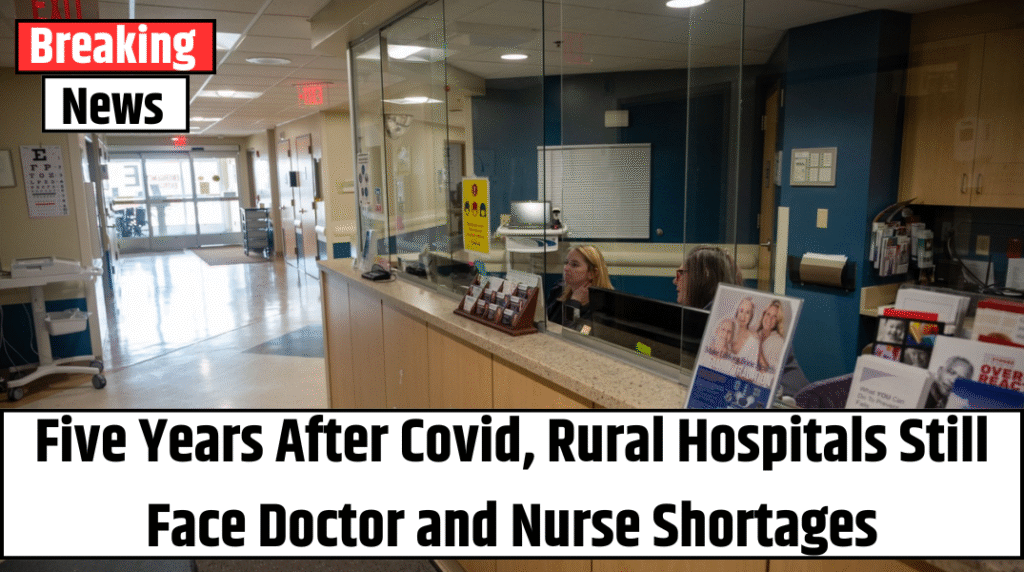In the quiet town of Sigourney, Iowa, the Keokuk County Hospital and Clinics facility is more than just a small-town hospital—it’s a lifeline. But with just 14 beds and no surgical or maternity services, its ability to serve the community hangs by a thread. And that thread is fraying.
The hospital’s emergency room, staffed around the clock, relies on only two full-time physicians. CEO Matt Ives has been trying to bring on a third, but post-pandemic recruitment is proving nearly impossible. “We’ve had doctors retire and others stop taking emergency shifts. It’s been an uphill battle since COVID,” Ives said.
And it’s not just Keokuk County. Roughly 40 miles to the east, Washington County Hospital and Clinics, with its modest 22 beds, is facing similar staffing challenges. CEO Todd Patterson pointed to an aging physician workforce that was already nearing retirement before the pandemic struck—COVID simply accelerated the exodus.
Five Years Later, the Toll Remains
Five years after the World Health Organization declared COVID-19 a global pandemic, rural hospitals across America—and especially in states like Iowa—are still reeling. The pandemic didn’t just push hospital systems to the brink; it drove an entire generation of healthcare workers to burnout, early retirement, and, in some cases, complete career changes.
“There’s a group of healthcare workers who left and will never return,” said Joanne Spetz, director of the Institute for Health Policy Studies at UCSF. “And those who stayed? Many are completely burnt out.”
Iowa now finds itself in the eye of the storm. According to the Iowa Medical Society, the state ranks 44th in the U.S. for patient-to-physician ratio, making it one of the worst states for access to doctors. “This isn’t a staffing problem anymore—it’s a full-blown crisis,” said IMS President Christina Taylor.
Also Read – Health Care AI Falls Short on Savings, Relies Heavily on Human Labor
A Crisis Decades in the Making
The shortage isn’t new. The pandemic just pulled the curtain back on a problem that had been growing for years.
The Association of American Medical Colleges estimates that the U.S. could be short up to 86,000 doctors by 2036 if the current trajectory continues. With an aging population and rising chronic illness rates, the strain is only expected to grow.
Even as medical student enrollment slowly rises, it’s a long-term solution to an immediate emergency. “If a high school graduate starts med school tomorrow, it’ll be nearly a decade before they’re practicing,” Patterson noted. “We need solutions that help us now.”
Nurses: The Forgotten Backbone
While much of the focus has been on physicians, the nursing shortage may be even more acute—especially in rural areas. In Keokuk County, Nurse Manager Sara Bruns recalled haunting moments during the pandemic when patients in critical condition couldn’t be transferred to larger hospitals. “There were nights when we had to tell families, ‘There’s nothing more we can do,’” she said.
For many nurses, the emotional toll was too great. Bruns said some colleagues simply left the profession altogether. Others, especially younger nurses, chose to relocate to urban areas for better pay and work-life balance.
Even now, her hospital continues to rely on expensive travel nurses—a strategy that wasn’t necessary before the pandemic but has become a budgetary burden.
Also Read – New Effort by Health Insurers Aims to Simplify Prior Authorization
Burnout Is a Policy Issue
Experts warn that retention must become a priority, not just recruitment. “You can’t just replace burnt-out staff with new workers and expect everything to be fine,” said Janette Dill of the University of Minnesota’s School of Public Health. “Support, safety, and respect in the workplace matter deeply.”
Healthcare workers report that patients have become more aggressive and less respectful since the pandemic began, adding emotional strain to an already difficult job. “Sometimes we don’t just feel tired—we feel unsafe,” Dill noted.
And the data backs her up. A CDC survey in 2022 revealed a sharp rise in burnout and mental health struggles among healthcare workers since 2018.
Where Is the Support Now?
Ironically, some nurses say they felt more valued during the worst parts of the pandemic than they do now.
“We used to get special contracts, bonuses, better pay—it made the long hours worth it,” said Gail Grimes, an ICU nurse in Des Moines. “Now, we’re expected to just push through without any of that.”
Grimes has watched peers leave Iowa for better-paying jobs in nearby states. She worries it’s not just about the money—it’s about whether hospital systems truly care about the wellbeing of their workers.
“There’s this quiet guilt you carry when you can’t give your patients everything they need,” Grimes said. “When you’re stretched so thin, care quality drops. That weighs on us.”
Policy Changes Are a Start, But Not Enough
Iowa lawmakers are attempting to address the crisis. Recent legislative efforts have included medical student loan forgiveness programs and dropping residency requirements for some internationally trained doctors. At least eight other states have followed suit, in hopes of opening the door for qualified physicians from abroad.
Also Read – Doctors Warn Measles Comeback Signals Deeper Public Health Crisis
But leaders like Patterson caution that these are slow-moving fixes. “It’s a step in the right direction, but not nearly fast enough to address what’s happening now.”
Until then, small-town hospitals like those in Keokuk and Washington counties will continue their fight—not just to save patients, but to survive.



